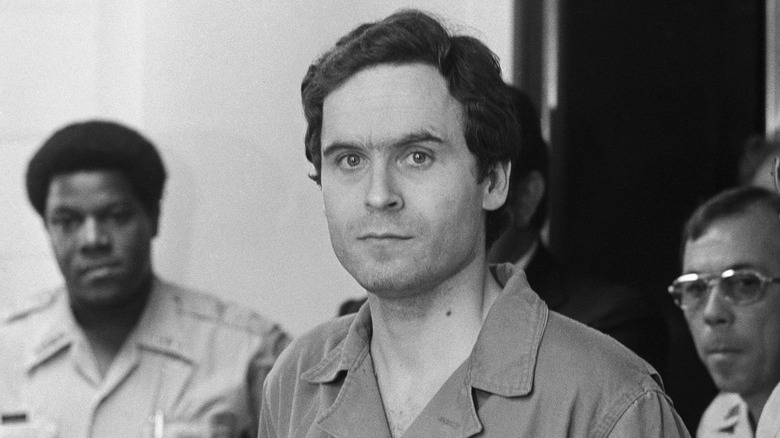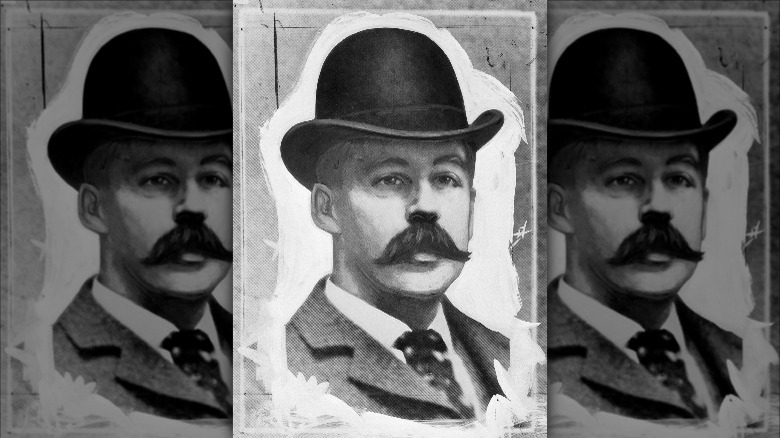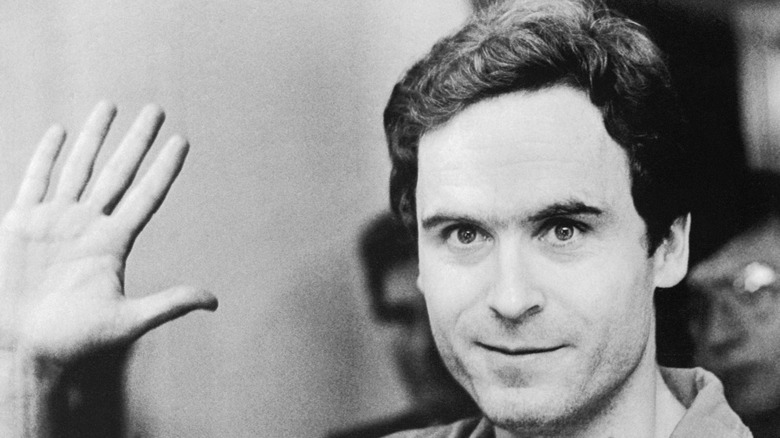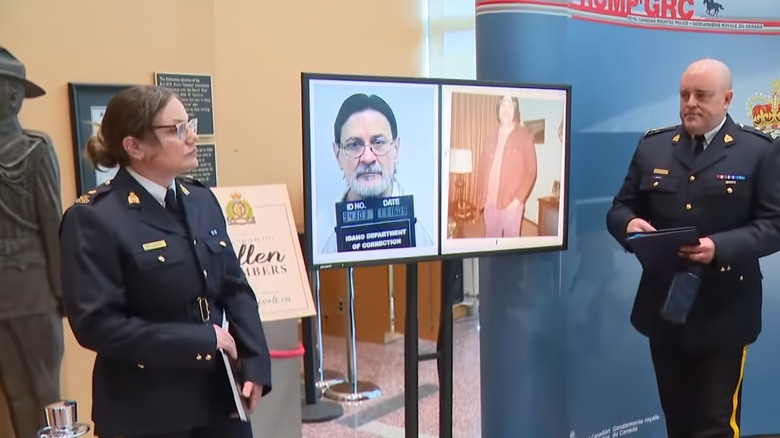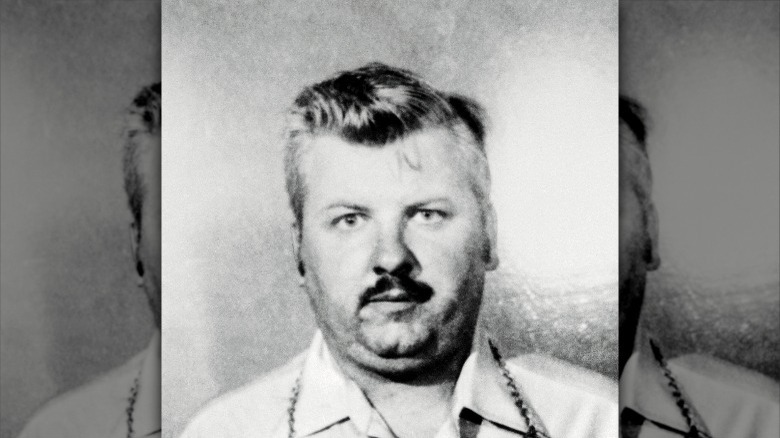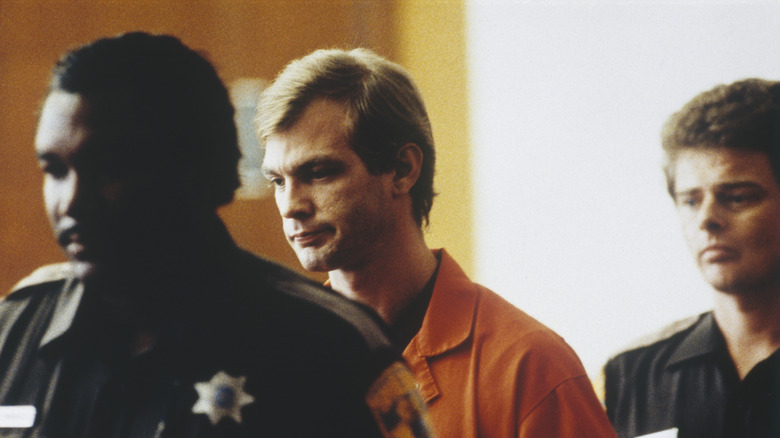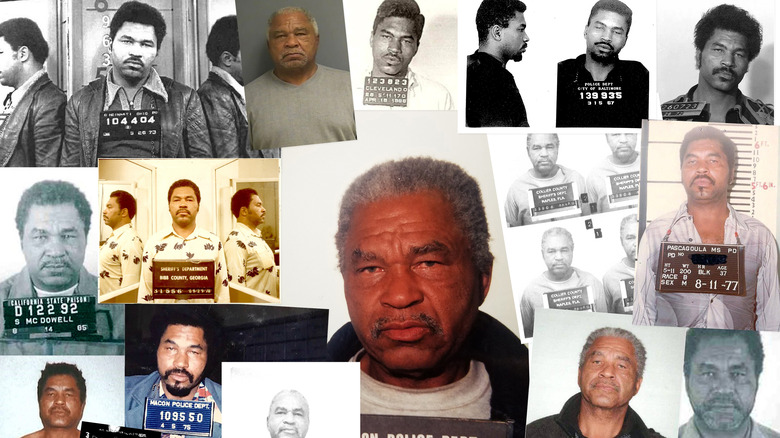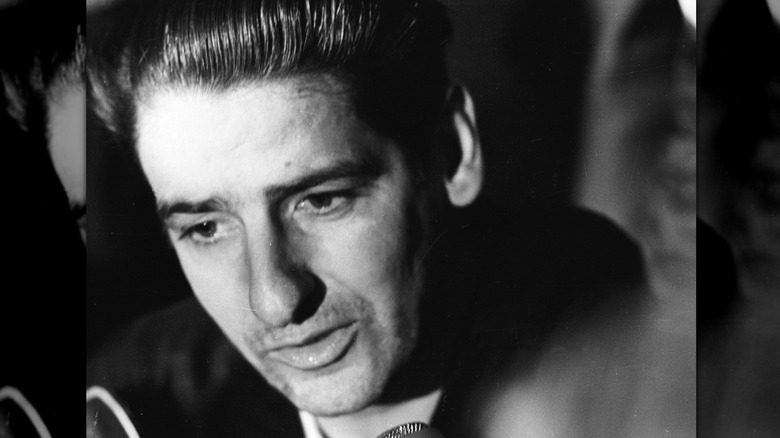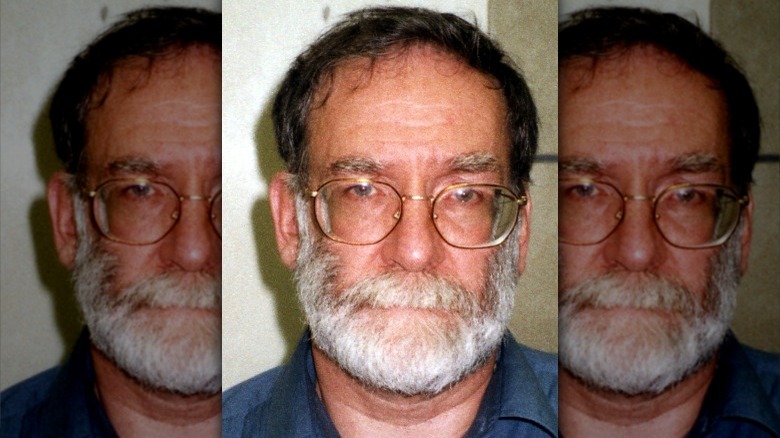Things We Learned About Serial Killers After They Died
It's hard to deny that there's quite the fascination with serial killers. All you need to do is take a look at the plethora of related podcasts, books, documentaries, and movies — indeed any form of media — to see that. So, with that in mind, there's probably a pretty decent chance you've heard a whole lot about the various serial killers that have operated over the years: Jeffrey Dahmer, Ted Bundy, John Wayne Gacy, and the rest of the frankly disturbingly long list. There's plenty out there on the atrocious things that they did during their lives, or the scandalous series of events that came to pass even after they were caught and found guilty.
But, unfortunately, the stories of these serial killers don't necessarily end with their deaths. Whether it be related to last-minute and mysterious confessions, sudden deaths, or unsolved mysteries, there are more than a few scenarios in which more information has come to light, even after one of those killers in question has died — sometimes, it even takes years for those truths to be uncovered. So here are a few of the times that the public learned something about serial killers even after they were dead and buried.
The following article includes references and descriptions of sexual assault and violence.
H. H. Holmes had a very interesting burial
Given that H. H. Holmes – real name Herman Webster Mudgett, and yes, the man did retitle himself after the famous fictional detective — killed people by luring them into a serial murderer's idea of a carnival fun house, it might not come as too much of a surprise that there were some unexpected findings in Holmes' gravesite which proved to be their own brand of confusing.
As far as anyone had been concerned, he'd been buried in Pennsylvania's Holy Cross Cemetery. And, sure, there Holmes had insisted on some odd requests — he wanted to be buried 10 feet deep and encased in concrete, rather than six feet and sans the concrete — but anything else hadn't been distinctly recorded by the cemetery. So that's what everyone had expected. But when conspiracies claiming that Holmes might be the infamous Jack the Ripper began to surface, researchers decided to disinter Holmes' body, just to check that it was actually him.
Long story short: the body is his. But what the researchers didn't expect was that those burial records would be severely lacking. As in, they found a coffin buried in ill-set concrete, painstakingly opened it up ... and then found it completely empty. The researchers were left scratching their heads, wondering if the body had been moved, or if the empty coffin was just a decoy. The latter seemed the most likely, and so they resolved to keep digging. After reaching down a few more inches, they found yet another concrete box — Holmes' true resting place.
Ted Bundy had even more victims
It's really hard to downplay the popular obsession that's arisen around Ted Bundy, often painting him as this handsome, charming psychopath. While Bundy's popular legacy is a question in and of itself, that interest has also led to quite a few conspiracy theories regarding his true victim list. There have long been 20 victims attributed to Bundy, but many others are believed to have been killed by him. Indeed, it's long been theorized that Bundy's first potential victim was actually 8-year-old Mary Ann Burr, and that he was only 14 when he killed her.
As it turns out, people had good reason to speculate. See, Bundy had technically admitted to more murders than he's been officially charged with, one of whom was 17-year-old Debra Kent. As far as everyone was aware, the teen had disappeared back in late 1974, during the intermission of a high school play, and she was never seen again. Bundy admitted to burying her body, even telling investigators the exact location, but no body was ever found. At least, not for many decades.
In 2015, human remains were unearthed, and investigators combed back through old cold cases, discovering that a piece of a human kneecap had been found and given to Kent's family. Upon retrieving that bone from them and running some DNA analysis, investigators found that the body was, indeed, Kent's, confirming Bundy was her killer — a fact that was released to the public years later in 2019, due to a resurging interest in Bundy.
Israel Keyes left behind some very disturbing paintings
Israel Keyes might be the closest equivalent to a fictional evil mastermind that you could ever imagine. While only four victims have been identified so far, with a possible fifth still yet to be confirmed, Keyes is credited with killing nearly a dozen people between 2001 and 2012, and he planned out his crimes with meticulous care: hidden stashes of supplies, long trips across the country to establish alibis, and macabre theater in which he posed the corpses of his victims and texted on their phones, pretending that they were still alive. Reportedly, he even planned on plastic surgery to make himself an even better killer. That whole approach might have had to do with his desire to play games with investigators, making deals with them for information. But the information well dried up when Keyes' name was released to the media, and he died by suicide in his own cell in late 2012.
But it turns out there was more to the story that the public was unaware of for quite some time. As finally revealed to the public in 2021, Keyes had left behind a number of things: a four-page suicide note, as well as 12 paintings, all created using his own blood. Eleven of those feature haunting images of human skulls, one of which included the phrase "We are one," and the last seemed to depict a crudely painted goat head.
Those paintings were the reason investigators believed Keyes to be responsible for 11 murders, and they released the information in the hopes that people might come forward with information to help identify them.
Gary Allen Srery wasn't even identified as a serial killer until after his death
One of the miracles of modern science is the fact that investigators are able to uncover the truth behind decades-old cold cases. Serial murder cases, fortunately, are no exception to that, as proved to be true with Gary Allen Srery.
There was a string of murders that took place in Calgary, Canada, from 1976 to 1977. All four victims — Eva Dvorak, Patricia McQueen, Melissa Rehorek, and Barbara MacLean — were young women who vanished under suspicious circumstances, with each of their bodies found within a day after their disappearances. It was clear that something strange was afoot, but all attempts at investigation just led to dead ends; for nearly half a century, answers proved to be less than forthcoming. But that all changed as the 21st century rolled around. The original investigators did take DNA from all the crime scenes, but at the time, it couldn't give them much information. In 2003, two of the deaths were linked, and by 2021, all four were linked to the same perpetrator. Genetic genealogy led investigators to finally identify Srery as the serial killer in 2024.
Nonetheless, Srery didn't see any of the consequences of those crimes, as he'd died in 2011 of natural causes while in prison for rape. As it turned out, he'd already had a storied criminal history, fleeing to Canada from the U.S. due to those rape allegations, and he lived there for nearly three decades using a number of false names.
John Wayne Gacy had even more victims than investigators initially thought
When John Wayne Gacy was caught in 1978, investigators could attribute 33 different murders to him. However, with all of them hidden away in the crawlspaces of his house, mysteries still remained about Gacy, and until 2011 — some 17 years after he was executed — there were still eight victims whose names weren't known. But that year was the turning point.
Back in the 1970s, the main way that investigators identified victims was through the use of dental records, but in the case of those unknown victims, there wasn't enough information to go on. However, when DNA profiling took center stage for solving crime, those victims were revisited, and three of them have since been positively identified. First was William George Bundy, a teenager who disappeared on his way to a party in October 1976. His family had long believed that Bundy had been one of Gacy's victims, but with the family dentist moving away and destroying their dental records, there was no way to confirm that.
Then, in 2017, there was another breakthrough. In 1976, James Byron Haakenson was a 16-year-old kid who had just moved to Chicago. Authorities now believe he was taken by Gacy the same day he'd arrived, though he couldn't be identified at the time, again due to lack of dental records. And, most recently, in 2021, Francis Wayne Alexander was identified — a shock to his family, who hadn't even filed a missing persons report at the time, thinking he simply wanted some time and space to himself.
Jeffrey Dahmer's Army roommate was too ashamed to speak out
While there's plenty of information about Jeffrey Dahmer's crimes, when it comes to the dark truth about Dahmer's time in the military, it would be remiss not to talk about the experiences of his military roommate, Billy Capshaw.
Capshaw enlisted in the military when he was only 17 and was sent to Germany to work as a medic, where he was assigned to live with Dahmer. Over the course of the next 18 months, Dahmer worked to exert complete control over Capshaw's life. He kept the only door key to the room, leaving Capshaw locked inside, and he somehow managed to make sure that Capshaw didn't even have regular assignments that would take him outside. Capshaw was quite literally trapped as Dahmer would regularly beat and assault him, forcing Capshaw to remain present for the torture should he try to dissociate — at least, at times when he wasn't drugged. All he could do to survive was monitor Dahmer's moods; his superiors even refused to do anything when he brought the matter to them.
The whole affair ultimately gave him severe PTSD and a lot of shame, to the point that, after Dahmer's arrest, he told the media he didn't believe Dahmer was capable of such violence. He didn't go public with his story until much later, waiting until after his father died: "It was too horrible, too embarrassing, and I didn't want my dad to know" (via The Wrap).
Many of Samuel Little's victims remain unidentified
Going by the numbers alone, Samuel Little can easily be considered the most prolific serial killer in all of American history. If you want the stats, after his 2012 arrest for his connection to a few murders that took place in the 1980s, he ultimately confessed to well over 90 murders spanning from 1970 to 2005. With most of his victims being female minorities, sex workers, drug addicts, or others generally on the fringes of society, many of their cases were initially dismissed, though further investigations have confirmed that he's responsible for 60 of those deaths.
But that's still a lot of murders unsolved, and a lot of victims lost to history, especially with Little himself dying in late 2020. With that in mind, the FBI released a bunch of information to the public about a year later, including the details Little told them about his various victims. Those details are disturbingly specific, often including in-depth descriptions of what that victim was wearing, what they looked like, and how they were killed. Unfortunately, Little also had a lot of trouble recalling exactly when and where any of those murders took place, so the hope was that someone might recognize the details and come forward with more information.
And, as it turned out, in 2023, one of those victims was successfully identified using previously unsubmitted evidence: Yvonne Pless, Little's earliest known victim, who was killed in 1977 in Macon, Georgia.
DNA evidence may have confirmed Albert DeSalvo to be the Boston Strangler
The whole story of Albert DeSalvo comes with quite a few twists and turns, some of which came after his death in 1973. As things are widely accepted, the Boston Strangler's reign of terror lasted from 1962 to 1964, during which time 13 women were killed in brutal fashion. DeSalvo confessed to those crimes, claiming to be the Boston Strangler, but mysteries abounded, with many doubting whether DeSalvo acted alone.
Closure seemed to come in 2013, when investigators could finally analyze DNA left at the scene of Mary Sullivan's murder. After making some progress by using the DNA of DeSalvo's nephew, they got a warrant to exhume the body of the killer. After running some tests, there was finally concrete proof linking DeSalvo with Sullivan, which seemed to indicate he was, in fact, the Boston Strangler.
As it turned out, though, things weren't quite that straightforward. Despite the clear genetic evidence, skeptics didn't think this was enough to prove anything; while it proved DeSalvo was involved in Sullivan's murder, it didn't necessarily mean he was actually the Boston Strangler, or that he committed all those other murders. And that was only further complicated when DailyMail released exclusive photos of DeSalvo's letters, dated a couple weeks before he died, in which he claimed, "I'm going to drop a bomb!!!" Evidently, he spoke out of his frustration with publishers and lawyers, and some questioned if he meant to recant his earlier claims, revealing that he wasn't the Boston Strangler after all.
The identities of Dean Corll's victims
For a while, Dean Corll — popularly known now as the "Candy Man" thanks to the candy factory owned by his family — was known as the most prolific serial killer in American history, as he's been credited with killing nearly 30 men between 1970 and 1973, alongside two teenage accomplices. At least, that was the case until one accomplice turned on Corll and killed him, after which point authorities began to search the area, coming upon 27 bodies within the week following his death.
Things did start getting a bit more confusing in the coming years, though. For one, by 1974, questions started to arise about one of the bodies found during the investigation; the burial site was miles away from the others, and the cause of death was found to be rather different than those killed by Corll. Fast forward another nine years, and a 28th body was found in the nearby area. But there were some initial questions as to who had killed and buried that body — questions that couldn't be answered for about two decades. As DNA analysis techniques became more refined, investigators were able to put a name to the body in 2014 — 17-year-old Joseph Lyle, who had gone missing back in 1973 — which seemed to indicate that Corll was, indeed, the killer.
All that said, there are some mysteries left: One body still remains unidentified, and one of Corll's young accomplices has implied that there could be as many as 20 more unknown victims.
The circumstances surrounding Harold Shipman's death
If you want a chilling tale, then look no further than Harold Shipman, the British doctor who did a lot more hurting than healing. While he was tried for 15 murders, estimates indicate that the real number might have been upwards of 200. As for how? Overdosing those patients on illegally purchased morphine, then falsifying their causes of death and medical records. He managed to get away with it for nearly thirty years until his arrest in 1998, and he died by suicide in 2004.
When it comes to the murders, there are relatively few questions left unanswered; after all, Shipman left a trail, as his changes to those medical records were, themselves, being recorded. However, it did turn out that his own death was a bit more mysterious. In fact, 12 years later, secret documents kept by the prison came to light, stating that Shipman planned to be dead by his 60th birthday so that his wife could be given larger pension payments — £100,000 immediately (equivalent to over $180,000 at the time) and £10,000 yearly, rather than only £5,000 per year.
Not only that, but the report revealed that prison officials were well aware of this, taking note of his suicidal ideation, even mentioning, "He has further commented that he will incite a lifer to attack him at this point with a view to being killed" (via The Independent). All despite the fact that, many years earlier, an official investigation claimed that prison staff had no idea that Shipman was suicidal, and so had no chance of preventing his death.
If you or anyone you know needs help with addiction issues, may be the victim of sexual assault, is experiencing mental health issues, or is struggling or in a crisis, contact the relevant resources below:
-
The Substance Abuse and Mental Health Services Administration website or contact SAMHSA's National Helpline at 1-800-662-HELP (4357).
-
The Rape, Abuse & Incest National Network website or contact RAINN's National Helpline at 1-800-656-HOPE (4673).
-
The Crisis Text Line by texting HOME to 741741, call the National Alliance on Mental Illness helpline at 1-800-950-NAMI (6264), or visit the National Institute of Mental Health website.
-
Call or text 988 or chat 988lifeline.org
